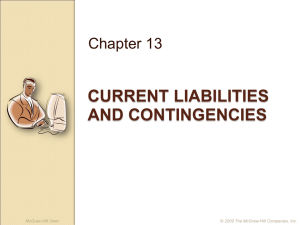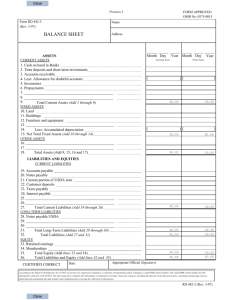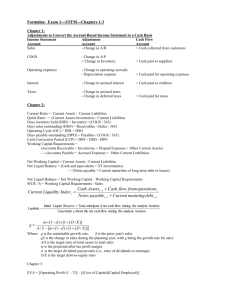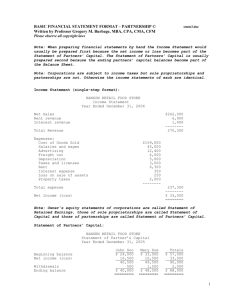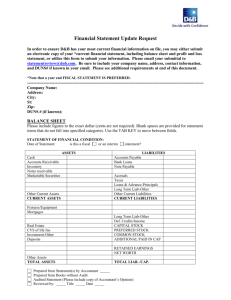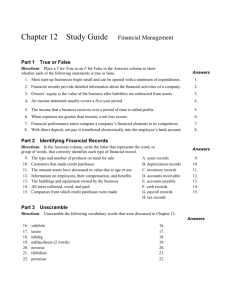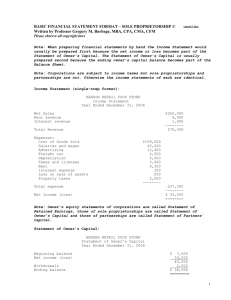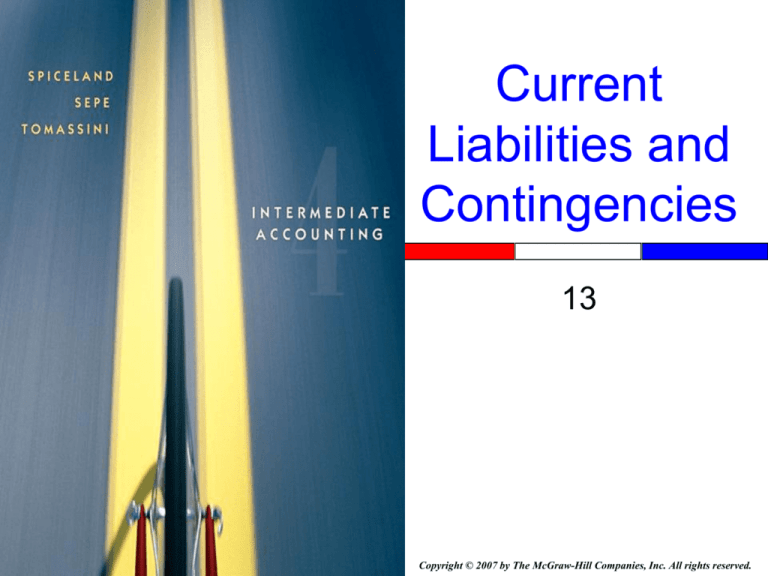
Current
Liabilities and
Contingencies
Insert Book Cover
Picture
13
Copyright © 2007 by The McGraw-Hill Companies, Inc. All rights reserved.
13-2
Learning Objectives
Define liabilities and distinguish between
current and long-term liabilities.
13-3
Liabilities
Probable
future
sacrifices of
economic
benefits . . .
. . . Arising
from present
obligations
to other
entities . . .
. . . Resulting
from past
transactions
or events.
13-4
What is a Current Liability?
LIABILITIES
Current Liabilities
Obligations payable within one year
or one operating cycle, whichever is
longer.
Expected to be satisfied with
current assets or by the creation
of other current liabilities.
Long-term Liabilities
13-5
Current Liabilities
Accounts
payable
Taxes
payable
Unearned
revenues
Cash dividends
payable
Current
Liabilities
Accrued
expenses
Short-term
notes payable
13-6
Open Accounts and Notes
Accounts Payable
Obligations to suppliers for goods
purchased on open account.
Trade Notes Payable
Similar to accounts payable, but
recognized by a written promissory
note.
Short-term Notes Payable
Cash borrowed from the bank and
recognized by a promissory note.
13-7
Credit Lines
Prearranged
agreements with a
bank that allow a
company to borrow
cash without following
normal loan
procedures and
paperwork.
13-8
Learning Objectives
Account for the issuance and payment of
various forms of notes and record the interest
on notes.
13-9
Interest
Interest on notes is calculated as follows:
Face
Amount
Amount
borrowed
×
Annual
Rate
Interest rate is
always stated
as an annual
rate.
×
Time To
Maturity
Interest owed is
adjusted for the
portion of the year
that the face
amount is
outstanding.
13-10
Interest-Bearing Notes
On September 1, Eagle Boats borrows $80,000 from
Cooke Bank. The note is due in 6 months and has a
stated interest rate of 9%.
Record the borrowing on September 1.
GENERAL JOURNAL
56
Page:
Date
Description
Sept. 1 Cash
Notes Payable
to record receipt of short-term
loan proceeds from Cooke
Bank
PR
Debit
Credit
80,000
80,000
13-11
Interest-Bearing Notes
How much interest is due to Cooke
Bank at year-end, on December 31?
a.
b.
c.
d.
$2,400
$3,600
$7,200
$87,200
13-12
Interest-Bearing Notes
How much interest is due to Cooke
Bank at year-end, on December 31?
a.
b.
c.
d.
$2,400
$3,600
$7,200
$87,200
Interest is calculated as:
Face
Annual
Time to
× Rate
× maturity =
Amount
$80,000
×
9%
×
4/12
$2,400 interest due to Cooke Bank.
=
13-13
Interest-Bearing Notes
Assume Eagle Boats’ year-end is December 31.
Record the necessary adjustment at year-end.
GENERAL JOURNAL
28
Page:
Date
Description
PR
Debit
Credit
13-14
Interest-Bearing Notes
Assume Eagle Boats’ year-end is December 31.
Record the necessary adjustment at year-end.
GENERAL JOURNAL
28
Page:
Date
Description
Dec. 31 Interest Expense
Interest Payable
to accrue interest on note due
to Cooke Bank
PR
Debit
Credit
2,400
2,400
13-15
Interest-Bearing Notes
Assume Eagle Boats’ year-end is December 31.
Record the necessary journal entry when the note
matures on February 28.
GENERAL JOURNAL
12
Page:
Date
Description
PR
Debit
Credit
13-16
Interest-Bearing Notes
Assume Eagle Boats’ year-end is December 31.
Record the necessary journal entry when the note
matures on February 28.
GENERAL JOURNAL
12
Page:
Date
Description
Feb. 28 Interest Payable
Interest Expense
Note Payable
Cash
to pay off note and interest
PR
Debit
Credit
2,400
1,200
80,000
83,600
Short-Term Notes Payable
Noninterest-Bearing
Notes
without a stated
interest rate carry an
implicit, or effective,
rate.
The face of the note
includes the amount
borrowed and the
interest.
13-17
Short-Term Notes Payable
13-18
Noninterest-Bearing
On May 1, Batter-Up, Inc. issued a one-year,
noninterest-bearing note with a face amount
of $10,600 in exchange for equipment
valued at $10,000.
How much interest will Batter-Up pay on the note?
Interest = Face Amount - Amount Borrowed
=
$10,600
$10,000
=
$600
Short-Term Notes Payable
Noninterest-Bearing
On May 1, Batter-Up, Inc. issued a one-year,
noninterest-bearing note with a face amount
of $10,600 in exchange for equipment
valued at $10,000.
What is the effective interest rate on the note?
Amount
Interest
=
Borrowed
Rate
$ 600 ÷ $ 10,000 =
6.00%
Interest ÷
13-19
13-20
Learning Objectives
Characterize accrued liabilities and liabilities
from advance collection and describe when
and how they should be recorded.
13-21
Liabilities from Advance Collections
Refundable
Deposits
Advances from Customers
Collections for Third Parties
13-22
Learning Objectives
Determine when a liability can be classified
as a noncurrent obligation.
Short-Term Obligations
Expected to Be Refinanced
A company may reclassify a short-term liability
as long-term only if two conditions are met:
It has the intent to
refinance on a
long-term basis.
and
It has demonstrated
the ability to
refinance.
The ability to refinance on a long-term basis
can be demonstrated by:
An existing refinancing agreement, or
By actual financing prior to issuance of the
financial statements.
13-23
13-24
Learning Objectives
Identify situations that constitute contingencies
and the circumstances under which they
should be accrued.
13-25
Contingencies
A loss contingency is an
existing uncertain situation
involving potential loss
depending on whether
some future event occurs.
13-26
Contingencies
Two factors affect whether a loss
contingency must be accrued and
reported as a liability:
1. the likelihood that the confirming event
will occur.
2. whether the loss amount can be
reasonably estimated.
Contingencies –
Likelihood of Occurrence
Probable
A confirming event is likely to occur.
Reasonably
Possible
The chance the confirming event will occur is
more than remote, but less than likely.
Remote
The chance the confirming event will occur is
slight.
13-27
13-28
Contingencies
Dollar Amount of Potential Loss
Likelihood
Probable
Reasonably possible
Remote
Known
Reasonably
Possible
Liability accrued
Liability accrued
and disclosure note and disclosure note
Disclosure note
Disclosure note
only
only
No disclosure
No disclosure
required
required
Not Reasonably
Estimable
Disclosure note
only
Disclosure note
only
No disclosure
required
A loss contingency is accrued only if a loss is probable
and the amount can reasonably be estimated.
13-29
Learning Objectives
Demonstrate the appropriate accounting
treatment for contingencies, including
unasserted claims and assessments.
13-30
Product Warranties and Guarantees
Product warranties inevitably entail costs.
The amount of those costs can be reasonably
estimated using commonly available estimation
techniques.
The estimate requires the following entry:
GENERAL JOURNAL
15
Page:
Date
Description
Debit
Warranty Expense
Estimated Warranty Liability
$$$
Credit
$$$
13-31
Extended Warranties
Extended
warranties are sold
separately from the product.
The related revenue is not earned
until
Claims are made against the
extended warranty, or
The extended warranty period expires.
13-32
Premiums
Premiums included with the
product are expensed in the
period of sale.
Premiums that are contingent
on action by the customer
require accounting similar to
warranties.
13-33
Litigation Claims
The
majority of medium
and large-size corporations
annually report loss
contingencies due to
litigation.
The most common
disclosure is a note to the
financial statements.
13-34
Subsequent Events
Events occurring between the year-end date
and report date can affect the appearance
of disclosures on the financial statements.
Cause of Loss Contingency
Fiscal Year Ends
Clarification
Financial Statements
13-35
Unasserted Claims and Assessments
End
No
Is a claim or
assessment
probable?
Yes
Disclosure
of claim or
assessment
No
Can amount
be estimated?
Yes
Record
estimated claim
or assessment
13-36
Gain Contingencies
Note that the prior rules have
supported the recording of LOSS
contingencies.
As a general rule, we
never record GAIN
contingencies.
13-37
Payroll-Related
Liabilities
Appendix 13
13-38
Payroll-Related Liabilities
Employers incur
several expenses
and liabilities
from having
employees.
13-39
Payroll-Related Liabilities
Gross Pay
FICA
Taxes
Medicare
Taxes
Federal
Income Tax
State and Local
Income Taxes
Net Pay
Voluntary
Deductions
13-40
Employee FICA Taxes
Federal Insurance Contributions Act (FICA)
FICA Taxes
6.2% of the first $90,000
earned in the year.
Medicare Taxes
1.45% of all wages
earned in the year.
Employers must pay withheld taxes
to the Internal Revenue Service (IRS).
13-41
Employee Income Taxes
Federal
Income Tax
State and
Local Income
Taxes
Amounts withheld depend on the employee’s earnings,
tax rates, and number of withholding allowances.
Employers must pay the taxes withheld from employees’
gross pay to the appropriate government agency.
13-42
Employee Voluntary Deductions
Voluntary Deductions
Amounts withheld depend on the employee’s request.
Examples include union dues, savings accounts,
pension contributions, insurance premiums, charities
Employers owe voluntary amounts withheld from
employees’ gross pay to the designated agency.
13-43
Employer Payroll Taxes
FICA Taxes
Medicare
Taxes
Federal and
State
Unemployment
Taxes
Employers pay amounts equal to that
withheld from the employee’s gross pay.
Federal and State
Unemployment Taxes
Federal
Unemployment Tax
(FUTA)
State
Unemployment Tax
(SUTA)
13-44
6.2% on the first
$7,000 of wages paid
to each employee (A
credit up to 5.4% is
given for SUTA paid.)
Basic rate of 5.4% on
the first $7,000 of
wages paid to each
employee (Merit
ratings may lower
SUTA rates.)
13-45
Fringe Benefits
In addition to salaries and wages,
withholding taxes, and payroll taxes,
most companies provide a variety
of fringe benefits.
Health
insurance
premiums
Life
insurance
premiums
Retirement
plan
contributions
Employers must pay the amounts promised to fund
employee fringe benefits to the designated agency.
13-46
End of Chapter 13


